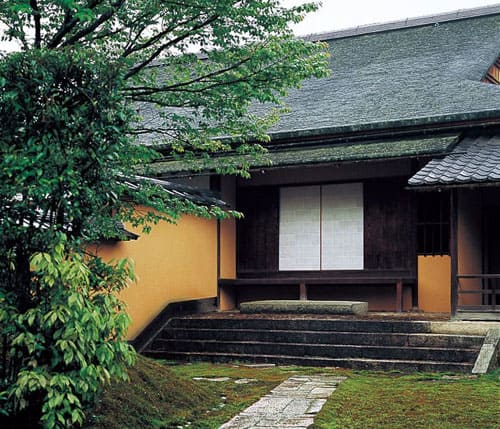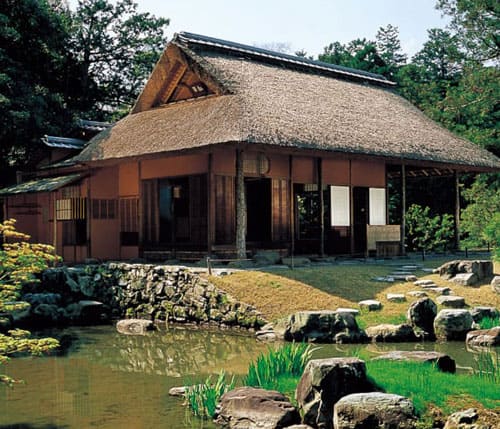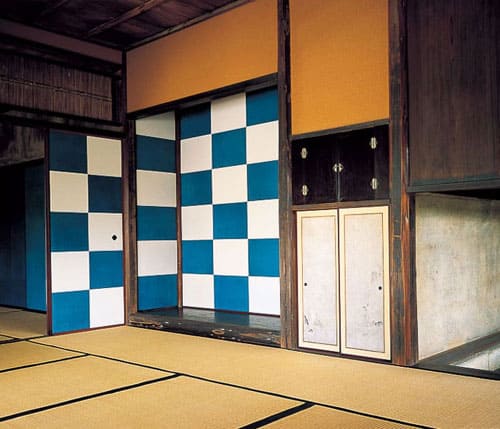桂離宮Katsura Imperial Villa
表門と御幸門Miyukimon
離宮の北側にある表門は桂離宮の正門である。特別の場合以外は開けられることはなく,普段の出入りは向かって右手,穂垣に沿いながら少し南側に回り込んだ所にある黒御門が使用されている。表門は,檜丸太を門柱とし,磨き竹を縦に隙問なく打ち並べてある。その少し奥に茅葺切妻屋根を棈という自然木の皮付丸太で支えた御幸門(写真)がある。この門は,後水尾上皇をお迎えするのに当たり智忠親王が造られたと伝えられるが,その後失われ,家仁親王の時に再建された。
The Miyukimon Gate was used as the entrance exclusively for members of the Imperial Family and their guests. This gate was built on the occasion of the visit of retired Emperor Gomizuno'o in the mid-17th century. Although the gate was torn down later, it was restored during the time of Prince Yakahito. The thatched gable roof is supported by log pillars with the bark still attached. The Miyukimon Gate shares a sense of silence and simplicity that are characteristic of the Katsura Imperial Villa.
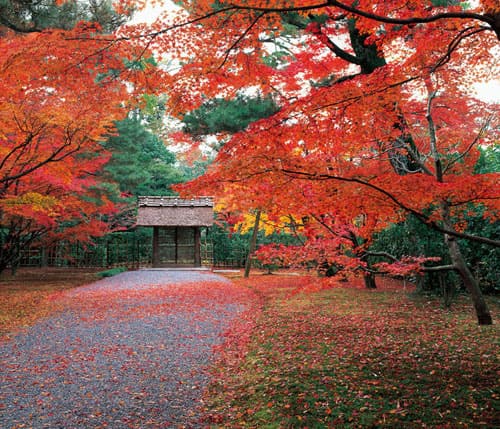
外腰掛Sotokoshikake
御幸道の中ほどから左に折れ,離宮苑内に入ると,外腰掛がある。茅葺寄棟造りの深々とした感じの屋根を皮付丸太で支えるだけの吹き放しであり,雪隠(便所)が付いている。茶室松琴亭の待合い腰掛である。腰掛の前を自然石と切り石を巧みに配した延段が長く延び,両端を二重桝形の手水鉢と丈の低い灯籠で引き締めている。対面は蘇鉄山であり,その蘇鉄は薩摩島津家から献上されたと伝えられている。
Located near the teahouse Shokintei, it is a small building where guests could wait until the host had finished preparing tea. It has a large roof supported by log pillars with the bark still attached and has a restroom in one of the corners. The beautiful paving stones and various steps, along with the cycad on the other side, are extremely visually appealing.
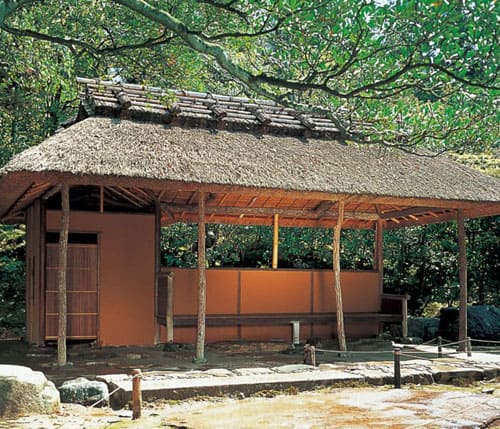
洲浜Suhama
黒く扁平な石が敷き詰められ池に突き出している。先端に灯籠を据えて岬の灯台に見立てて海を演出している。また,その先の中島と石橋のつながりは,天の橋立に見立てたものと言われている。
There are many flat stones packed onto the Suhama shore, which just out into the pond. There is a lantern at the tip and the intention is to create an image of the sea, with the lantern representing a light house on a cape. Further more, the stone bridge connecting the islet represents Amanohashidate, which is known as one of the best three scenic spots in Japan, along with Miyajima in Hiroshima Prefecture and Matsushima in Miyagi Prefecture.
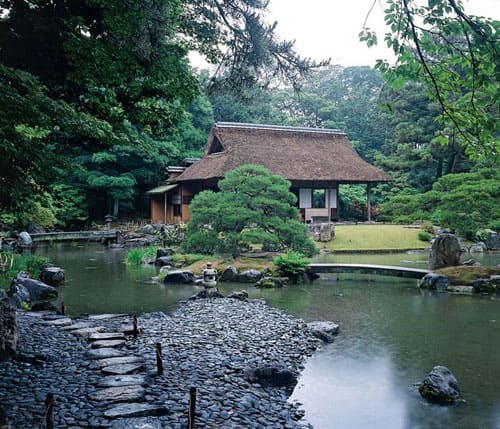
松琴亭Shokintei
松琴亭は,桂離宮で最も格の高い茅葺入母屋造りの茶室である。一本の切石を渡した橋を渡ると松琴亭である。橋を渡る手前から松琴亭屋根の妻に「松琴」の扁額が見える。後陽成天皇の宸筆で,銘は拾遺集巻八雑上の「琴の音に峯の松風通ふらし・・・・・・」の句から採られている。にじり口の内側は三畳台目(茶室用の畳)の本格的な茶室で,遠州好みの八窓の囲いである。松琴亭外観は,東,北,西の三方から眺めるとそれぞれに異なる風情が楽しめる。北側廊下の竈(かまど)構えと一の間の床や襖の青と白の市松模様は大胆かつ柔軟な発想と創意によるもので,そのデザインは現代になおいきいきと相通ずる斬新さをもっている。
Crossing a large stone bridge brings the visitor to the entrance of the Shokintei, the most important teahouse at the villa. "Shokin" means the sound of a koto (Japanese harp) and the whistle of the wind passing through pine trees. Because the entrance is extremely small, visitors must hunch over to pass through to the interior. It is a typical Japanese teahouse and there are eight windows on the inside of the entrance. A different perspective of the Shokintei can be enjoyed from the east, north and west. The ichinoma, or first room, has a blue-and white checkered pattern on the sliding door and tokonoma alcove. This is the result of bold and flexible creativity and ingenuity and it appears as novel and contemporary today as it did back then.
賞花亭Shokatei
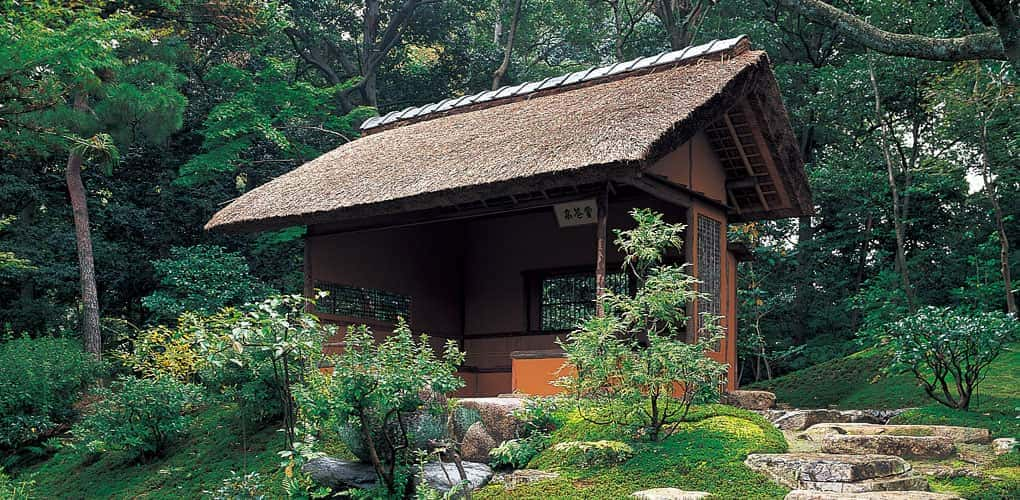
中島の一つで小高い丘の斜面を飛石に導かれて登ると,途中に水螢の名を持つ石灯籠があり,登りきった所に峠の茶屋風の賞花亭がある。苑内で最も高い位置にある。松琴亭と同じようにほぼ北に向かい,消夏のための小亭であり,茅葺切妻屋根に皮付きの柱を用いている。南側の竹の連子窓を通してみる景色は深山幽邃の趣きを備えている。
Climbing up the small hill patterned with stepping stones on one of the small islets in the pond, visitors will discover a stone lantern called mizuhotaru (firefly in the water) on the way. The Shokatei, built in a style like a teahouse at the pass, is located at the highest point of elevation in the garden. It is an ideal location to stay in the summer.
園林堂Onrindo
賞花亭の山裾にあり,本瓦葺宝形造り屋根の持仏堂である。今は安置されているものはなく建物だけが残っている。離宮全体の雰囲気と異質ではあるが,またそれなりの景観でもある。扁額は後水尾上皇の宸筆である。
This structure is located at the base of the hill on which the Shokatei is located and it was where the memorial tablets of the Katsura family were previously kept. Now only the structure remains.
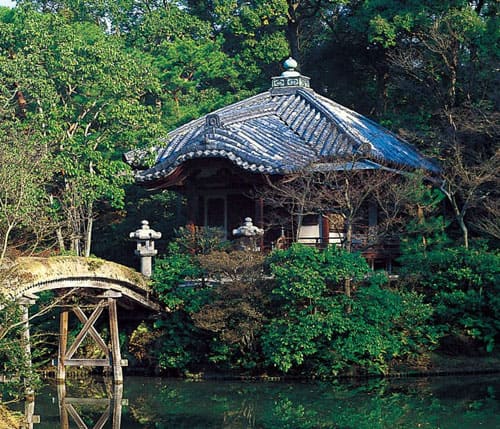
笑意軒Shoiken
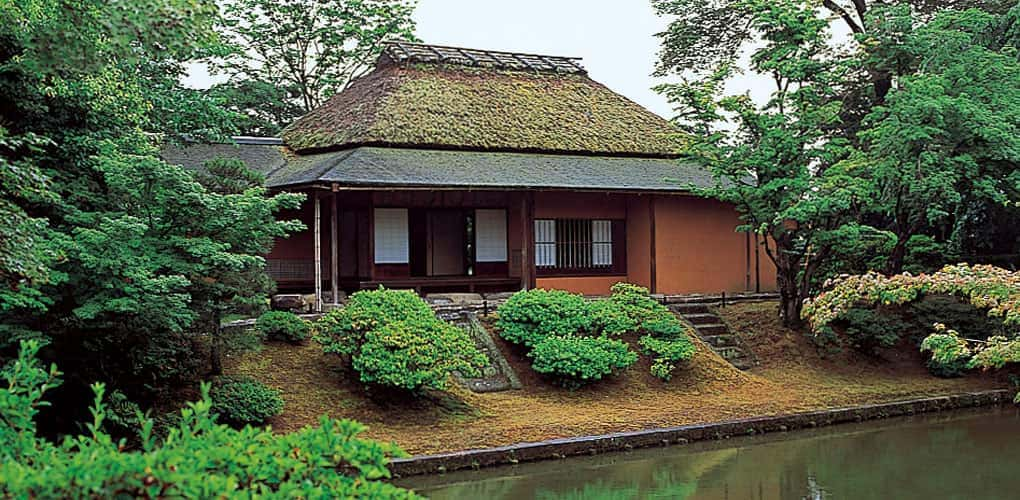
笑意軒は,切り石を直線的に畳んだ人工的な汀線に面した田舎屋風の茶室である。茅葺寄棟造りの屋根に柿葺の廂を付けた間口の長い建物である。縁側のある口の間の腰高障子の上に横並びに六つの丸い下地窓を設けているが,下地の組み合せをそれぞれに違えてあり,連子窓の格子の材質にも木や竹を微妙に使いわけている。その上方に掛けられている「笑意軒」の扁額は曼殊院良恕法親王の筆である。内部は襖で区切られるが,天井は一つのつながりをもっており,室内を広く見せる配慮と考えられる。蹲踞(茶庭の手水鉢)は「浮月」の銘がある。舟着場の照明用に火袋に蓋のような笠を載せた三光灯籠が置かれている。
The Shoiken is a country-style teahouse beside the shoreline that has cut paving stones leading to it in a diagonal line. In the room with a narrow wooden passageway along the building facing the garden, there are six round windows lined up horizontally above the waist-high papered sliding door, but the combination of the sills is different for every one and the material used for the lattice window is a subtle combination of wood and bamboo. The interior is partitioned by fusuma, or sliding doors, but the ceiling is not partitioned. This is thought to give an appearance of airiness inside. At the boat mooring there are the sankotoro, or "three-light lanterns." They are designed to represent sunlight, moonlight and starlight. They have a cover that is shaped like the paper cover for a lantern.
書院全景Shoin
桂離宮の中枢をなす書院群は,東から古書院,中書院,楽器の間,新御殿と,雁行形に連なって立ち並んでいる。古書院には,池に面して月見台が設けられ,中書院は,一の間,二の間,三の間からなり,楽器の間は楽器などを格納していたところである。新御殿は,智忠親王が後水尾上皇をお迎えするために増築された建物である。一の間の南に櫛型窓の付書院をそなえ,その脇に棚板,地袋,袋棚を巧みに組み合わせた桂棚(写真)と呼ばれる違い棚がある。この棚は,修学院離宮の霞棚,三宝院の醍醐棚とともに天下の三棚と称されている。なお,昭和51年7月から平成3年3月にかけて各書院及び茶室の解体大修理が行われた。
The cluster of the Shoin, which consist of the Koshoin, Chushoin, Gakkinoma and Shingoten, are built next to one another along an east-west axis. The Koshoin has a Tsukimidai, or a moon-viewing veranda, facing the pond. The Chushoin has three rooms and Gakkinoma was where musical instruments were stored. The Shingoten was added on by Prince Toshitada on the occasion of the visit by retired Emperor Gomizuno'o. Throughout the period from 1976 to 1991 large-scale restoration work took place, with each Shoin and teahouse being dismantled and then rebuilt.
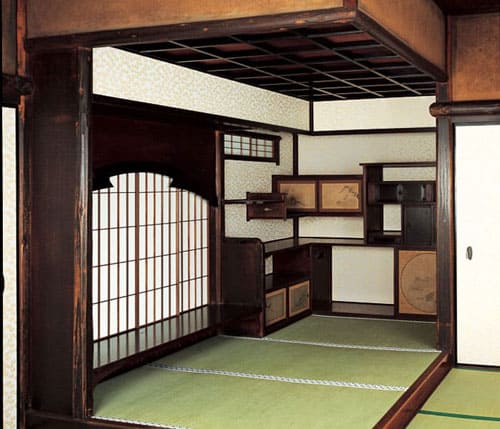
月見台Tsukimidai
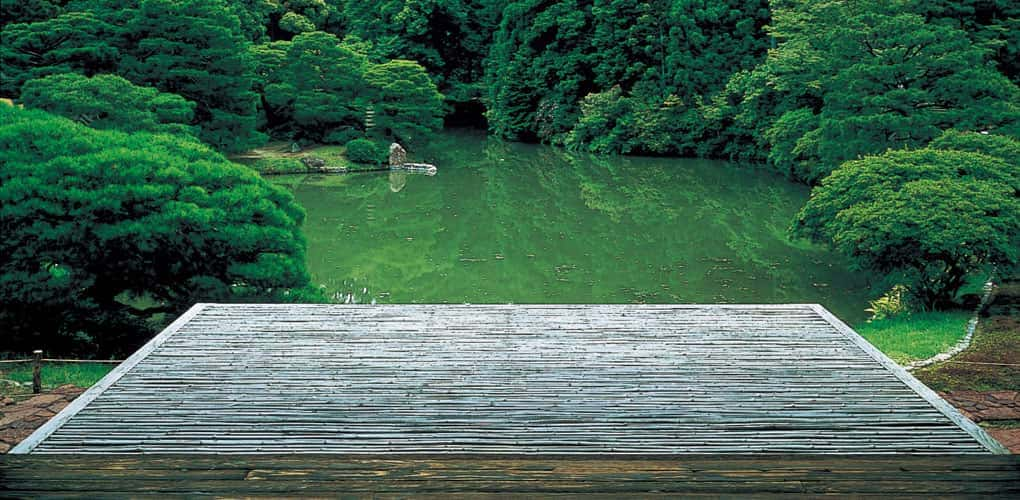
月を観賞するために,古書院二の間の正面,広縁から池に突き出すように竹簀子で作られている。月見はいうまでもないが,苑内の主要な景観が一望でき,納涼の設備としても申し分ない。
This is a veranda for moon-viewing. Situated in front of the ninoma, or the second room, one of the rooms of the Koshoin, the Tsukimidai is built in a way so that it protrudes from the broad passageway along the building facing the garden toward the lake and is constructed with bamboo flooring. It goes without saying that this is not only a lovely place to enjoy the view of the moon, but also an ideal place to enjoy a panoramic view of the entire villa gardens. It is a cool and refreshing place to be in summer.
月波楼Gepparo
月波楼は古書院に近い池辺の高みに建つ茶亭で,正面中央を広い土間にして開放的である。月を見るのによい位置にあり,土間の右手の部屋は,池を眺めて見晴らしが良く,土間の奥の座敷から北を見ると池は隠れて見えない趣向である。化粧屋根裏の竹の垂木が舟の底のような形に組んである。
The Gepparo is a teahouse standing on a promontory above the shore of the pond near the Koshoin. There is a spacious earthen area to the front-center of the structure. It is a good place to watch the moon and another feature is that there is no interior ceiling in the teahouse and the back of the roof looks like the bottom of a boat.
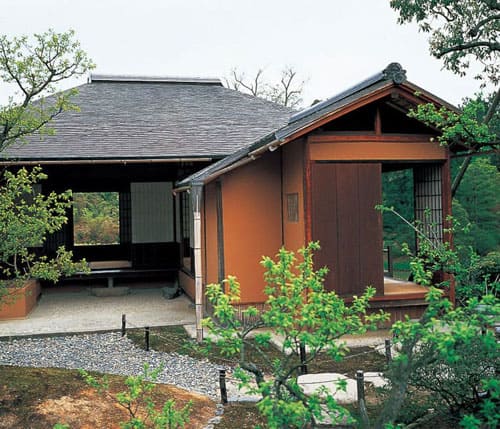
御輿寄Okoshiyose
書院の玄関であり,前庭は杉苔で覆われている。中門から切り石を敷き詰めた延段が御輿寄に向けて延びているが,今までの苑路には見られなかった切り石の堅さのある構成で更に石段を四段上がると一枚石の大きな沓脱がある。六人の沓を並ベられることから「六つの沓脱」という。
This is the entrance to the Shoin, the main house. The front garden is covered with moss and there are stones paving the route toward the Okoshiyose from the inner gate. This stone-paved walk is of the highest quality made by combining angularly cut stones of various shapes. If visitors go up the four stone steps leading to the Okoshiyose, there is a large stone where they can remove their shoes, which has enough space to accommodate six pairs of shoes.
